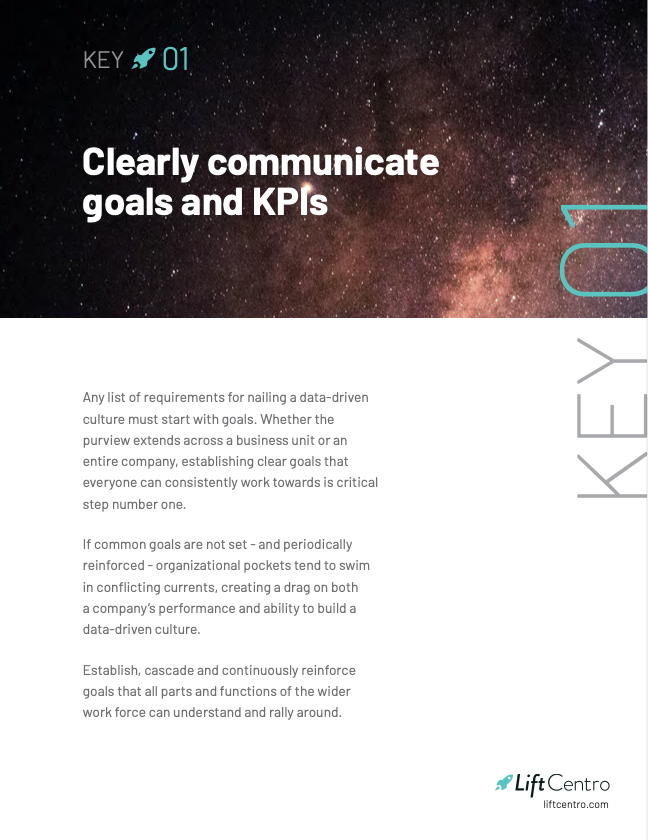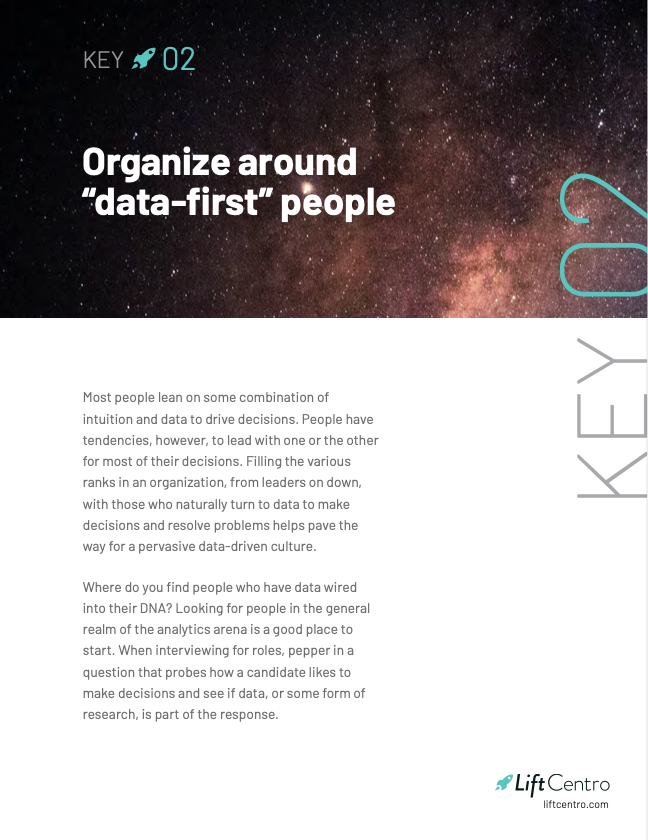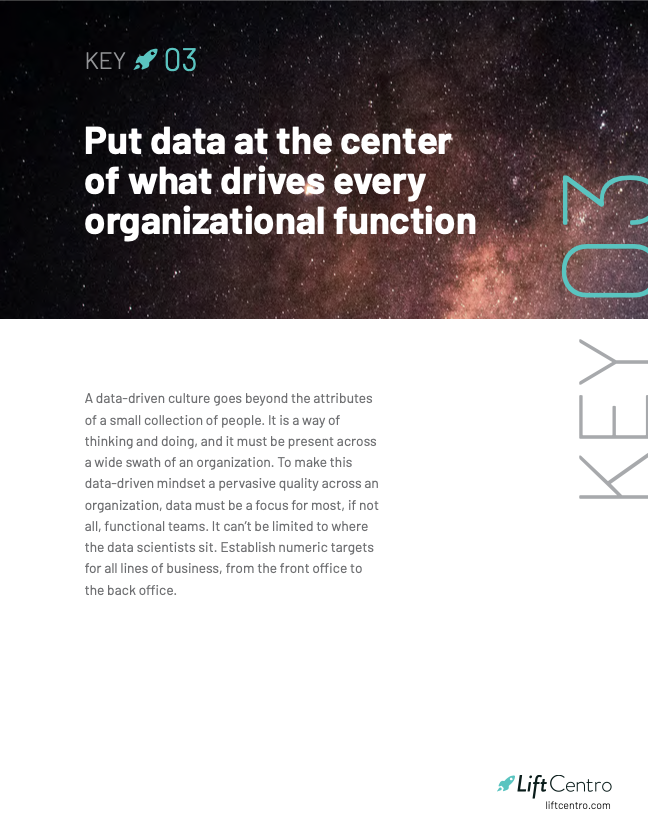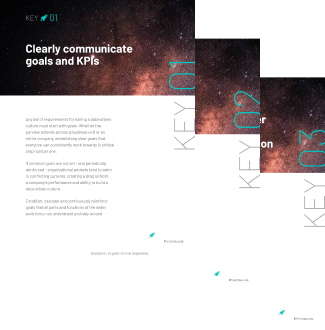How to build a data-driven culture
from a foundation of experimentation
20 Keys to Pave the Way
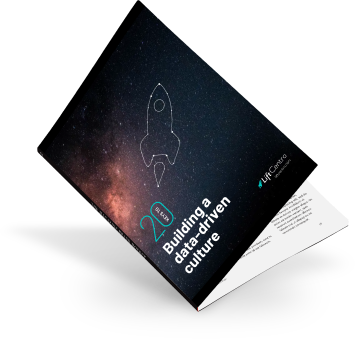
1. Clearly communicate goals and "KPIs"
Any list of requirements for nailing a data-driven culture must start with goals. Whether the purview extends across a business unit or an entire company, establishing clear goals that everyone can consistently work towards is critical step number one.
If common goals are not set – and periodically reinforced – organizational pockets tend to swim in conflicting currents, creating a drag on both a company’s performance and ability to build a data-driven culture.
Establish, cascade and continuously reinforce goals that all parts and functions of the wider work force can understand and rally around.
2. Organize around “data-first” people
Most people lean on some combination of intuition and data to drive decisions. People have tendencies, however, to lead with one or the other for most of their decisions. Filling the various ranks in an organization, from leaders on down, with those who naturally turn to data to make decisions and resolve problems helps pave the way for a pervasive data-driven culture.
Where do you find people who have data wired into their DNA? Looking for people in the general realm of the analytics arena is a good place to start. When interviewing for roles, pepper in a question that probes how a candidate likes to make decisions and see if data, or some form of research, is part of the response.
3. Put data at the center of what drives every organizational function
A data-driven culture goes beyond the attributes of a small collection of people. It is a way of thinking and doing, and it must be present across a wide swath of an organization. To make this data-driven mindset a pervasive quality across an organization, data must be a focus for most, if not all, functional teams. It can’t be limited to where the data scientists sit. Establish numeric targets for all lines of business, from the front office to the back office.
4. Bake data-driven practices into personal KPIs
Let’s face it: when we’re struggling to keep up with various work tasks, we have a tendency to prioritize based on our given KPIs. Financial incentives are consistently good as both a way to motivate and to guide us on where we focus our daily energies.
So naturally, a way to drive data-driven behaviors is to weave them into at least some of an individual’s KPIs. Base some goal on the extent to which they use data to inform their decision- making. As an example, identify a sensible number of actions individuals take, based on hard data, as a goal to aspire to. Tee up their quarter or year so they can get after it.
5. Spotlight people by recognizing their exemplary focus on data
Open recognition for strong work is both good for the individual being recognized, but it also motivates his or her peers to reach farther, going forward. For example, creating awards specifically for being data-driven in how the individual approaches their daily work helps plant seeds for a data-driven culture.
Shine light on those who regularly turn to data – analyses, experimentation, customer data, and so on – to make decisions. When making such awards visible to the broader organization, cite an example or two of how the individual exhibited their data- driven behavior, so others can start to visualize what this can look like in their daily work life.
6. Share knowledge with colleagues
Despite how commonplace it is to learn how to share in our early developmental years of life, sharing knowledge with colleagues, at many organizations, is not a frequent enough phenomenon. Sometimes, silos and competitive instincts stand in the way. More innocent impediments can also be the cause: lack of time and focus on the concept of sharing insights. Circling back to the personal KPI discussion, KPIs are not often centered on how much knowledge is shared with colleagues. Behavior tends to follow those other KPIs.
To be truly data-driven, it would behoove organizations to consider tinkering with KPIs, to put more emphasis on information sharing. The reality is that organizations can take more collective action on data when data-driven insights are accessed and internalized by more people across the larger organization.
A variety of platforms can help propel insight sharing – from general utilities like Google sheets and slides and Trello, to utilities like Datatinga, built specifically for proliferating insight knowledge across organizations.
7. Supercharge ideation
Facilitating the spread of insights across a distributed work force has the direct benefit of getting more people in a position to take action on data. But knowledge sharing has longer-term benefits as well. Getting easy-to-digest insights in front of colleagues inspires deeper thinking. More thinking means more ideas. Herein lies a multiplier effect that helps a data-driven culture to proliferate.
8. Knock down silos
Culture entails a prevailing mindset across divisions within an organization. For a data-driven culture to flourish, the same mindset needs to exist in different groups. One way to create that consistent mental current is to knock the silos down and get groups to collaborate more with one another.
Ironically, it goes both ways. A way to knock the silos down is to proliferate knowledge sharing, which in itself creates the connective tissue across disparate functional and geographic teams.
9. Use gamification concepts to influence behavior
When we present data to colleagues in a quiz-like, gamified manner (e.g., “Which of these experiences resulted in more orders per visitor?”), and then reveal the statistically significant, data-backed winner, it will inevitably surprise some in the audience that the result did not align to their gut instinct.
Rinse and repeat a few times and the whole audience will be surprised. This ends up being a fun way to reinforce the power of data (and get people to turn to it more often!).
10. Store insights in an insights repository
Having lots of data does not translate into a data-driven culture. Data on its own does not embody value. Action is what makes data valuable. What paves the way for organizations to act on data is a framework where data is regularly communicated in the form of easy-to-understand insights.
The insights, in turn, must be easy for a distributed work force to find. If insights are stored in disparate inboxes, spreadsheets and meeting recordings, or wider-use project management platforms, truly data-driven cultures are hard to implement.
Data-driven cultures require insight repositories like Datatinga™ that are built specifically for insight management and communication. Mixing insights with other types of content (e.g., experiments, issues, enhancements, bugs and features) can create clutter and distractions, both of which can impede adoption and insight consumption.
11. Make consumption easy
Data visualization has come a long way over the last couple of decades. Lines, charts and graphs look more electric than ever before. Standard dashboards with all of their geometric eye candy serve their purpose. But when you want to convey key points to people who are not familiar with the research work behind the data (i.e., usually most of the people in your organization), these visualizations can take a lot of time and energy to consume. And as slick as they can be, if people tune out before they comprehend the information, then they aren’t getting the job done.
Instead, tell data stories. And make the stories short. After all, it’s words and images, not fancy visualizations, that most people are accustomed to engaging with in everyday life. Make the information easy to consume.
12. Present insights in a consistently visual manner
Speed and ease-of-use have already been noted as keys to turning data into action – the transformation that really defines a data-driven culture. These important tenets bring us to our current point, consistency in how insights are presented.
Normally, when we process information, we first piece together the elements that sit in front of us. Where is the visual information? Where are the descriptions? Where is the underlying data? Where is the top line summary? After that processing, we can start to internalize the essence of the insight.
If insights are presented in a uniform format, all the time, the initial piecing together process can be skipped. As consumers of the information, this enables all of our energy to focus on what matters most – the essence of the insight itself and how it can be applied to our daily work.
13. Make sure insights are backed by statistically significant data
A tremendously told story that is rooted in unfounded, statistically insignificant data is, unfortunately, not a good story. Touting information that stems from statistically insignificant data can drive actions that end up being a waste of time, energy and money.
It is important to run experiment data through statistical significance calculators and ensure good sample sizes. Another way to accrue more sample size and get the added benefit of gauging directional consistency for experiment outcomes is to run the same test concept in multiple contexts (different product pages for example).
14. Encourage experimentation and big thinking
Swing for the fences. Think big. Go for the gusto. There are loads of expressions that convey the concept that going big starts with thinking big. Thinking big becomes easier when we have a safety net in place. High jumpers don’t jump high without that comfortable padding to land on.
The world of digital gives experimentation this same kind of padding. Failing can be fast and fast failure means fast learning. Deploy analytics and testing programs to create an environment where people across your organization are encouraged to come up with ideas of any shape and size. Build a testing program with consistent rigor and governance – and go for the gusto.
15. Treat insight communications like the specialized skill that it is
Writing and content publishing are special skills and not everyone has them. The process of crafting insights and communicating them involves sound written communication skills. Choose your insight crafters carefully. This process is not just about communication – it’s also about eliciting action from others.
Take the take time to tell the data stories in a compelling manner. Focus on the key points. Make it digestible. Link to more background information as needed, and “fun-size” your information so that consumption is easy.
16. Make data actioning an accountable task
When it comes to breakdowns in how organizations move from data to value, a typical culprit is a lack of clear accountability as to who is going to take charge and ensure that an action is being taken on the newfound learnings. Many companies do the research and communicate insights. Usually, it’s a one-shot communication. Meeting presentations are delivered. Recordings sometimes get created. They rarely get listened to. And then insights vanish into the hazy humidity.
Overcome these challenges by identifying a person or team to be responsible to carry that insight forward – to take action on the data. Taking action on data improves the ROI on the research that uncovered the insight to begin with. These actions are also what move organizations from having data to being data driven.
17. Democratize the ideation process
Instilling a data-driven culture requires that individuals from any pocket or level of the wider organization feel empowered to put ideas on the table. The feeling of being able to contribute to the direction of the larger collective inevitably fuels more ideas.
Not all ideas are great, but many are. Create standardization with the intake process, to help identify the ideas that are viable and worth pursuing. Have a standard method for prioritization to efficiently bubble up the best ideas and weed out the others.
18. Utilize customer-centric, qualitative research
In the age of the customer, we cannot talk about how to be data-driven without putting some focus on customers. Maintain dialogue with customers through in-person research or surveys. Understand what they seek, what makes them tick and what ticks them off. Know your customer.
Once you accumulate this knowledge, pollinate it across your organization. The more your wider organization knows about what your target audience looks for in products and service offerings (and what is not important), the better you can shape your products for the long haul.
19. Tap the quantitative and qualitative 1-2 punch
Being data-driven means using both quantitative and qualitative data methods to learn about your customers and what motivates them to become customers.
Use quantitative data tactics like analytics and split testing, where samples sizes are often good, to learn about what attracts your customers. Then use qualitative approaches like user testing and surveys to understand the why. Why are they attracted to your offerings? Understand both the what and the why. Platforms like Wevo allow you to get the best of both worlds – qualitative feedback with strong sample sizes.
20. Use data to tell winning customer stories
Good customer stories weave together numbers and emotions. When customer successes can be communicated with hard data and the power of feelings and emotion, it’s time to toot your horn. And don’t just tout the stories, externally. Motivate your teams, internally, by educating them about the customer successes.
Data-backed showcases both motivate the work force and reinforce the importance of using data to energize and drive meaningful action.
